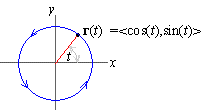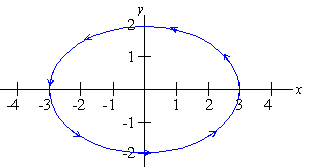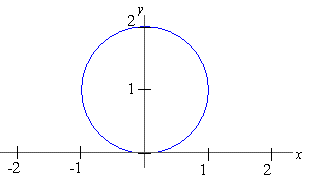Part 2: Using Identities to Eliminate the Parameter
In many instances, trigonometric identities are used to find the
equation in x and y corresponding to the graph of a given vector-valued
function. In particular, the following identities occur frequently in this
context:
In addition, we may also on occasion use identities such as 2sin(t) cos( t) = sin( 2t) and ete-t = 1.
EXAMPLE 2 Sketch the curve
parameterized by r(t) =
á cos( t) ,sin( t)
ñ for t in [ 0,2p] .
Solution: Since x = cos( t) and y = sin(t) , we begin with
Substituting x = cos( t) and y = sin( t) into
the identity yields
which is the unit circle. Moreover, the initial and terminal points are
Since the initial and terminal points are both ( 1,0) , we must
determine the orientation by choosing a value of t near an endpoint of [0,2p] :
|
t = |
|
: |
x = cos |
æ
è
|
|
ö
ø
|
= |
|
, y = sin |
æ
è
|
|
ö
ø
|
= |
|
|
|
Thus, the orientation of the curve is counterclockwise:

The function r( t) =
á f(t) ,g( t)
ñ , t in [ a,b] , parameterizes a closed curve if r(a)
= r(b) , if f(t) and g(t) are continuous, and if
the curve has a well-defined orientation. The circle in
example 2 is an example of a closed curve.
EXAMPLE 3 Sketch the curve
parameterized by r(t) =
á 3cos( t) ,2sin( t)
ñ for t in [ 0,2p] .
Solution: Since x = 3cos( t) and y = 2sin(t) , we begin with
Substituting cos( t) = x/3 and sin( t) = y/2
thus yields
If t = 0 or t = 2p, then x = 3 and y = 0. Thus, the initial and terminal
points are the same and correspondingly the graph of r(t) =
á 3cos( t) ,2sin( t)
ñ for t in [ 0,2p] is the entire ellipse
with counterclockwise orientation.
|
|
+ |
|
= 1 |
 |
|
Unfortunately, a parameterization may not define an orientation for
a curve, in that the parameterization may trace the curve from the initial
point to a point on the curve and then may retrace the curve back to where
it started, as we will see in the next example.
EXAMPLE 4 Find the Cartesian equation and sketch the curve r( t) =
á cos( 2t) ,cos(t)
ñ for t in [ 0,2p] .
Solution: Since x = cos( 2t) and y = cos(t) , we use a double angle identity:
| cos( 2t) |
= |
2cos2( t) -1 |
| x |
= |
2y2-1 |
|
Moreover, r( 0) =
á cos( 0), cos( 0)
ñ =
á 1,1
ñ , r( p/2) =
á cos( p) ,cos( p/2)
ñ =
á -1,0
ñ , and r(p) =
á cos( 2p) , cos( p)
ñ =
á1,-1ñ. Also, r( 3p/2) =
ácos(3p),cos(3p/2)ñ =
á -1,0 ñ and r(2p) =
á cos( 4p) , cos(2 p)
ñ =
á1,1ñ. Thus,
the curve starts at ( 1,1) , progresses to ( -1,1) , and then retraces the curve in returning to ( 1,1) .
Consequently, the orientation is not well-defined.
EXAMPLE 5 Find the Cartesian equation of the curve
|
r( q) =
á 2sin(q) cos(q) ,2sin2( q)
ñ, q in [ 0,p] |
|
Solution: Since 2sin( q) cos( q) = sin( 2q) and 2sin2( q) = 1-cos( 2q) , we can rewrite r as
|
r( q) =
á sin( 2q),1-cos( 2q)
ñ |
|
which implies that x = sin( 2q) and y = 1-cos(2q) . Since
and since cos( 2q) = 1-y, we must have
Thus, r( q) =
á 2sin( q) cos( q), 2sin2( q)
ñ is a circle with radius 1 centered at ( 0,1) .

Check your Reading: What is the orientation of the curve
in example 5?


